
HMS Devastation was a Royal Navy Driver class steam sloop, unusually powered as a paddle steamer designed by Sir William Symonds and launched in 1841. [1] She saw no major action but did have some noteworthy commanders.

HMS Devastation was a Royal Navy Driver class steam sloop, unusually powered as a paddle steamer designed by Sir William Symonds and launched in 1841. [1] She saw no major action but did have some noteworthy commanders.
She was built at the Royal Dockyard, Woolwich and launched on 3 July, 1841 under command of Hastings Reginald Henry. She was armed with 6 guns (including a pair of 68lb guns) and a crew of 149 men. She served her first year in the Mediterranean. [2]
In May 1842, command transferred to John James Robinson for a period before going back to Captain Henry. In November 1843, it passed to Swynfen Carnegie and in February 1844, William Hewgill Kitchen (who was later Governor of Ascension Island) took command. [1]
From October 1845 to March 1846, she was recommissioned at Woolwich and put under Commander Edward Crouch and became part of the Squadron of Evolution serving off the west coast of Africa passing to Captain Charles Hotham in May 1846. Hotham was later Governor of Victoria. [1]
In 1846, under Hotham she joined the Experimental Squadron in Portsmouth. After a brief time back with Captain Crouch it passed to Reginald Thomas John Levinge, third son of Sir Richard Levinge, baronet. [3] This was still off the coast of West Africa. In September 1847, command passed to Commander Reynell Charles Michell for 12 months who took her to the Cape of Good Hope. [4]
In a change of scene in May 1851, she sailed to North America and the West Indies under Captain Colin Yorke Campbell. From 1853 to 1858, she stayed in the West Indies under successive command of: Algernon Frederick Rous de Horsey; Edward Marshall; Leveson Somerset; Charles Wake; and John Kennedy Erskine Baird. [1]
In December 1861, she was posted to the Pacific under John Dobree McCrea. After six months command passed to John William Pike, under whose command in 1864 there were reports of an outbreak of bronchopneumonia. [5]
Still in the Pacific at Christmas 1864 command passed to the Hon Walter Hylton Joliffe who returned her to England in August 1866. She was broken for scrap in 1866.
Hotham's letters of 1846 to 1848 from the Devastation to England are preserved in the National Archive at Kew. [6]
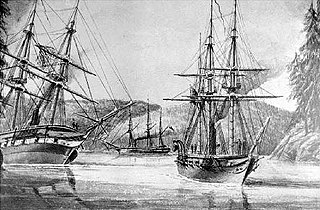
HMS Plumper was part of the 1847 programme, she was ordered on 25 April as a steam schooner from Woolwich Dockyard with the name Pincher. However, the reference Ships of the Royal Navy, by J.J. College, (c) 2020 there is no entry that associates this name to this build. The vessel was reordered on 12 August as an 8-gun sloop as designed by John Fincham, Master Shipwright at Portsmouth. Launched in 1848, she served three commissions, firstly on the West Indies and North American Station, then on the West Africa Station and finally in the Pacific Station. It was during her last commission as a survey ship that she left her most enduring legacy; in charting the west coast of British Columbia she left her name and those of her ship's company scattered across the charts of the region. She paid off for the last time in 1861 and was finally sold for breaking up in 1865.

Admiral of the Fleet Sir William Parker, 1st Baronet, GCB, was a Royal Navy officer. As a captain's servant he took part in the Battle of The Glorious First of June in June 1794 during the French Revolutionary Wars and, as a captain, he participated in the capture of the French ships Marengo and Belle Poule at the action of 13 March 1806 during the Napoleonic Wars. He was detached on an independent command on the Tagus in September 1831 with a mission to protect British interests during the Portuguese Civil War. As Commander-in-chief of the East Indies and China Station, he provided naval support at various actions between 1841 and 1842 during the First Opium War. Appointed Commander-in-Chief, Mediterranean Fleet in February 1845, he was briefly First Naval Lord in the First Russell ministry from 13 July 1846 to 24 July 1846 but gave up the role due to ill health before returning to his command with the Mediterranean Fleet.

Admiral of the Fleet Lord John Hay, was a Royal Navy officer and politician. After seeing action in 1842 during the First Opium War, he went ashore with the Naval Brigade and took part in the defence of Eupatoria in November 1854 and the Siege of Sevastopol in spring 1855 during the Crimean War. He also took part in the Battle of Taku Forts in August 1860 during the Second Opium War. As a politician, he became Member of Parliament for Wick and later for Ripon. He was sent to the Mediterranean in July 1878 to take control of Cyprus and to occupy it in accordance with decisions reached at the Congress of Berlin. In a highly political appointment, he was made First Naval Lord in March 1886 when the Marquis of Ripon became First Lord of the Admiralty but had to stand down just five months later when William Gladstone's Liberal government fell from power in August 1886.

HMS Hydra was the lead ship of her class of wooden steam paddle sloops of the British Royal Navy, launched in 1838 at Chatham Dockyard. After taking part in operations during the Syrian War in 1840, she then served on anti-slavery operations and also as a survey vessel. She was scrapped in 1870.
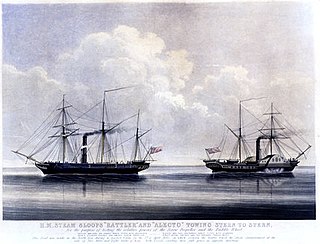
HMS Rattler was a 9-gun steam screw sloop of the Royal Navy, and one of the first British warships to be completed with screw propulsion. She was originally ordered as a paddle wheel 4-gun steam vessel from Sheerness Dockyard on 12 March 1841. She was reordered on 24 February 1842 as a propeller type 9-gun sloop from HM Royal Dockyard, Sheerness, as a new vessel. William Symonds had redesigned the ship as a screw propeller driven vessel.
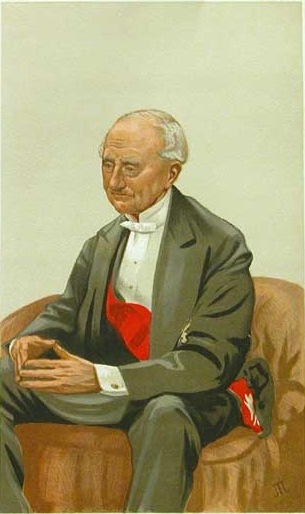
Admiral Sir Hastings Reginald Yelverton, was a Royal Navy officer. As a junior officer he took part in a major action against pirates off Candia in June 1826 and was involved in protecting British interests during the Portuguese Civil War during the early 1830s. He saw action in the Crimean War as Captain of one of the two ships that captured a Russian barque beneath the batteries at Ekenäs in Finland in May 1854. Then in July 1873 he took part in the suppression of the Cantonal Revolution in Cartagena. He became First Naval Lord in September 1876 and in that role implemented a series of economies demanded by the Disraeli ministry but was also involved in ordering the small, cheap and thoroughly unsuccessful ironclad Ajax-class battleships.
Admiral Sir William Houston Stewart, was a senior British naval officer who, after a long, active career, eventually held the office of the Controller of the Royal Navy from 1872 to 1881.
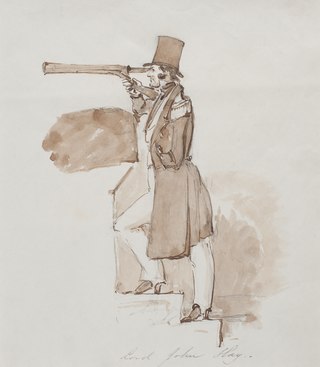
Rear Admiral Lord John Hay, was a British naval officer and Whig politician.
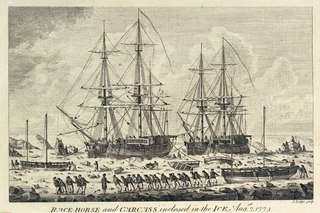
HMS Carcass was an Infernal-class bomb vessel of the Royal Navy, later refitted as a survey vessel. A young Horatio Nelson served aboard her as a midshipman on an expedition to the Arctic in 1773.
Admiral Sir Lawrence William Halsted GCB was an officer of the Royal Navy who served during the American War of Independence and the French Revolutionary and Napoleonic Wars.

HMS Iris was a 26-gun sixth-rate frigate launched on 14 July 1840 from Devonport Dockyard. She spent some time with the West Africa Squadron suppressing the slave trade and later with the East Indies Station was involved in operations in Borneo. Iris was the first flagship of the Australia Station between 1859 and 1861 during which time she participated in the First Taranaki War. In 1864 she was extensively modified to allow her to ferry transatlantic telegraph cable to the cable-laying ship Great Eastern. She was decommissioned and sold off in 1869.

HMS Niger was originally slated to be built as a Sampson designed sloop; however, she was ordered as a First-Class sloop with screw propulsion on 20 February 1845 to be built at Woolwich Dockyard, along the design developed by Oliver Lang and with a hull like the Basilisk designed paddle sloops. Her armament and engine were to be like the Encounter Design building at Pembroke. A second vessel (Florentia) was ordered on 26 March 1846 but after her keel was laid at Pembroke Dockyard, her construction was suspended on 6 October 1846 then cancelled three years later, on 22 May 1849. Niger She conducted important propulsion trials, finally proving the superiority of screw propulsion and served in West Africa, the Crimea, China, the East Indies and Australia. She took part in the New Zealand wars in 1860 and was sold for breaking in 1869.

HMS Phoenix was a 6-gun steam paddle vessel of the Royal Navy, built in a dry dock at Chatham in 1832. She was reclassified as a second-class paddle sloop before being rebuilt as a 10-gun screw sloop in 1844–45. She was fitted as an Arctic storeship in 1851 and sold for breaking in 1864.

Reginald Thomas John Levinge (1813–1848) was a British aristocrat and second in line to the Levinge baronetcy but never became baronet. He served as a commander in the Royal Navy. He was donor of some of the Levinge Papers which are held in the National Library of Ireland.
HMS Archer was initially ordered as one of two Rifleman type gunvessels on 25 April 1846. With her construction suspended in September 1846, she was reordered on as a sloop on 25 April 1847 to be constructed to a design of John Edye as approved on 25 August. With the exception of two years on Baltic service during the Russian War of 1854 to 1855 she spent the majority on the West Coast of Africa on the anti-slavery patrol. This service involved anti-slavery work on the coasts of the Bight of Benin, and was notoriously unhealthy, with tropical diseases taking a heavy toll of British seamen. One of her commanders died and three others were invalided. Archer was reclassified as a corvette in 1862. She finally returned to Home waters, being sold for breaking in January 1866

HMS Wasp was an Archer type sloop ordered on 25 April 1847 from Deptford Dockyard. Two references stipulate that Parthian, ordered with Archer the year prior was renamed Wasp when ordered as a sloop. However, Parthian remained on the books at Deptford, as a Rifleman type gunvessel until cancelled in June 1849. Therefore Wasp was a new build. She served on many different stations during her career, including West Coast of Africa, in the Mediterranean and Black Sea during the Russian War of 1854 - 55, on the South East Coast of America, Cape of Good Hope where she went aground twice and the East Indies before being sold for breaking in December 1869.
HMS Medea was one of the initial steam-powered vessels built for the Royal Navy. On 10 January 1831 the new First Lord Sir James Graham, 2nd Baronet gave orders that four paddle vessels be built to competitive designs. The vessels were to be powered by Maudslay, Son & Field steam engines, carry a schooner rig and mount one or two 10-inch shell guns. Initially classed simply as a steam vessel (SV), she was re-classed as a second-class steam sloop when that categorization was introduced on 31 May 1844. Designed by Oliver Lang, the master shipwright of Woolwich. She was launched and completed in 1834, took part in the Syrian Coast Campaign and was broken up in 1867.
HMS Vesuvius was initially a Steam Vessel second class designed by Sir William Symonds, Surveyor of the Navy, and built at Sheerness. She was commissioned and participated in the bombardment of Acre in 1840, during the Russian War she was in the Black Sea and the Sea of Azov in 1855. Her last overseas posting was in the West Indies. She was sold for breaking in June 1865.
HMS Polyphemus was an Alecto-class sloop designed by Sir William Symonds, Surveyor of the Navy. Originally classed as a steam vessel (SV3), her classification would be changed to a Third Class Sloop. She initially served in the Mediterranean, west coast of Africa and the Baltic. She was wrecked on the Baltic side Jutland on 29 January 1856.
HMS Scourge was a Bulldog-class sloop designed by Sir William Symonds, Surveyor of the Navy. Originally she was ordered as a Driver-class sloop, however, under Admiralty Order of 26 December 1843 she was directed to be built to a new specification. She was initially commissioned for service with the Channel Squadron before moving to the North America and West Indies Station. She then served in the Mediterranean then the west coast of Africa. Her final service was in the Mediterranean. She was broken in 1865.